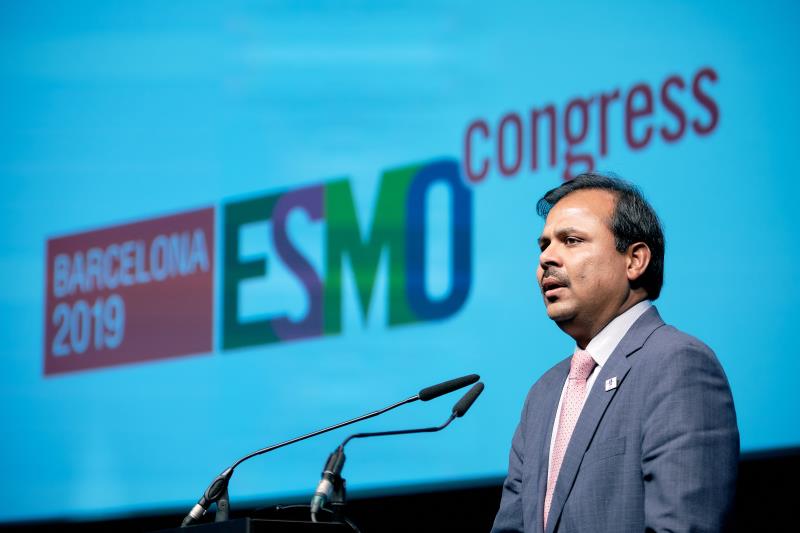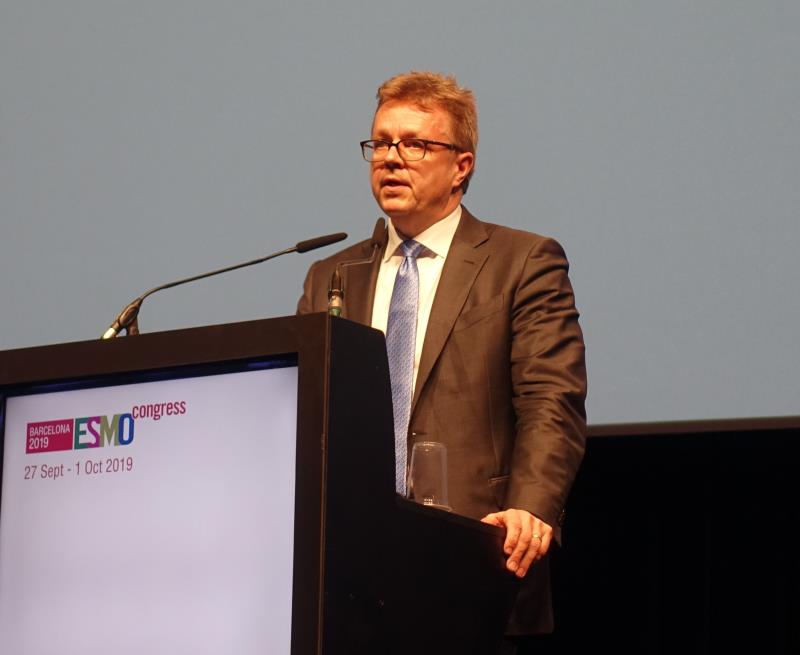 Dr Ramesh Ramalingam
Dr Ramesh RamalingamFinal overall survival (OS) results from the double-blind phase III FLAURA study reinforce osimertinib as the standard frontline treatment for epidermal growth factor receptor-mutated (EGFRm) non–small cell lung cancer (NSCLC), say leading oncologists at ESMO 2019.
“The survival results with first-line osimertinib are both statistically significant and clinically meaningful for EGFRm patients,” said FLAURA lead investigator Dr Suresh Ramalingam from the Winship Cancer Institute of Emory University in Atlanta, Georgia, US. “The OS results for the control group are also among the highest reported for EGFRm patients. I also wish to point out that osimertinib is the first EGFR-tyrosine kinase inhibitor (TKI) monotherapy to show a statistically significant OS benefit vs another EGFR-TKI in lung cancer therapy.”
Despite crossover between arms at progression, osimertinib improved median overall survival (OS) by 6.8 months vs the first-generation EGFR-TKI erlotinib or gefitinib in this EGFRm NSCLC population. Median OS was 38.6 months with osimertinib vs 31.8 months with gefitinib or erlotinib. This translates to a 20-percent reduction in the risk of death (hazard ratio [HR], 0.799; p=0.0462). At the final data cut-off, 54 percent of patients in the osimertinib arm remained alive vs 44 percent in the erlotinib/gefitinib arm. [ESMO 2019, abstract LBA5_PR]
Osimertinib is FDA-approved as a frontline treatment for EGFRm NSCLC, based on the primary progression-free survival (PFS) analysis of FLAURA. [N Engl J Med 2018; 378:113-125] “The final OS analysis clearly reinforces osimertinib in this setting,” said Ramalingam. “Despite prolonged exposure, osimertinib presented a favourable and consistent toxicity profile.”
Best therapy first
Treatment-naïve patients (n=556) with EGFR-positive (exon 19 deletion or L858R) advanced or metastatic NSCLC were randomized to receive frontline osimertinib at 80 mg once daily (n = 279) or a standard care EGFR-TKI (gefitinib 250 mg or erlotinib 150 mg once daily; n=277). Some had CNS metastases. The median duration of exposure to osimertinib was 20.7 months whereas 11.5 months to the control.
OS at 1 year was 89 percent for osimertinib vs 83 percent for erlotinib or gefitinib. At 2 years, OS was 74 percent for osimertinib vs 59 percent for control. At 3 years, 28 percent of patients remained on osimertinib vs 9 percent on erlotinib or gefitinib.
“The take-home message is we should give the best therapy first,” said Ramalingam. “Thirty percent of patients in both arms of the trial did not receive subsequent therapy after progression, and for the vast majority, it is because they died. For those patients, first-line treatment is the only shot they had.”
Data unclear for Asians
OS improved with osimertinib across all key patient subgroups, but data for Asian populations were unclear, Ramalingam said. HR for OS was 0.995 in Asian patients (n=347) and 0.542 in non-Asian patients (n=209). “In the Asian group, the curves separate early and remain favourable for osimertinib for 3 years. But at this time point, I would urge caution as the number of events is low and there’s a high degree of censoring. To us, the benefit for osimertinib is seen across all key subgroups.”
Osimertinib vs other EGFR-TKIs
“Osimertinib is a third-generation EGFR-TKI that is very different from other EGFR inhibitors. It is highly selective to the EGFR receptor and therefore has a much better safety profile vs the other drugs. It has higher penetration in the brain and can induce responses in 70–90 percent of patients with brain metastases, which is a common problem with EGFRm lung cancer. Finally, osimertinib not only blocks exon 19 and 21, it also blocks the T790M pathway, which is the most common resistance mechanism for patients treated with first- and second-generation EGFR inhibitors,” Ramalingam explained.
The magnitude of OS benefits for osimertinib in the FLAURA trial, including the overall sequence of therapies, should be discussed with the patients, commented Dr Pilar Garrido from the Ramon y Cajal University Hospital, Madrid, Spain during a press conference held prior to the presentation. “Patients should be told that frontline osimertinib offers an OS advantage and is well tolerated, but when this treatment fails, the only option is chemotherapy,” she said. “Maximizing the duration of chemotherapy-free treatment is important for many patients, but if we want to know the most effective sequence of TKIs we need studies specifically designed for that.”
Give the best, or roll the dice
Sequencing-wise, Ramalingam said osimertinib should be used in the frontline setting preferentially. “Not every patient develops T790M,” he said. “If you go with a sequence, only 30–35 percent of patients will get a chance to receive osimertinib. So, you either give the best drug first, or roll the dice. But you’ll lose the opportunity to treat 2 out of 3 patients.”
 Dr Pasi Jänne
Dr Pasi JänneMeanwhile, discussant Dr Pasi Jänne from the Dana-Farber Cancer Center in Boston, Massachusetts, US likens the FLAURA results to “hitting for the cycle” in baseball. “The team batter hits a single, double, triple, and home run, all in one game. When we think about therapies, they often do not deliver on multiple clinical endpoints, but this is not the case for FLAURA. Osimertinib has delivered on multiple endpoints – response rate, PFS, CNS activity and then, the home run today, which is OS.”
Jänne also advised against starting with an older EGFR-TKI for the same reasons cited by Ramalingam. “This is not optimal clinical care. We are not smart enough to figure out who will get T790M, and not everyone will be well enough to receive additional treatment. Additionally, tissue or liquid biopsies are not always feasible or available,” he said. “With the median OS improvement of 7 months, the FLAURA results are practice-changing. In fact, in the US, practice has already changed with the PFS data.”